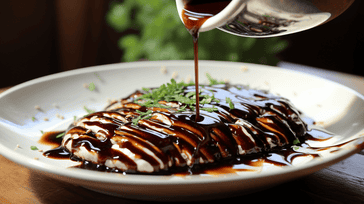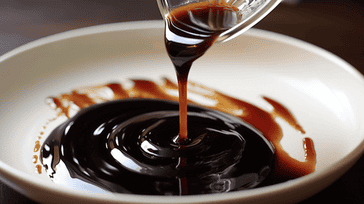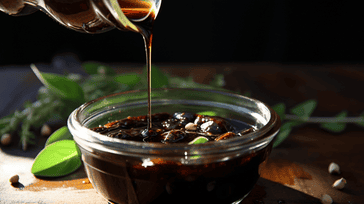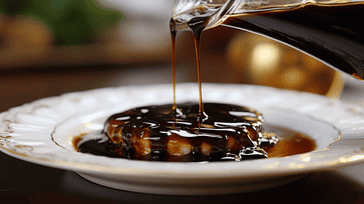- 03 June, 2025
- 49,805 Views

Are you looking to add a rich and flavorful condiment to your dishes? Look no further than balsamic reduction! This versatile ingredient can elevate any meal and impress your guests. And the best part? You can easily make it at home with just a few simple ingredients.
Balsamic reduction is a thick, syrupy sauce made by reducing balsamic vinegar over low heat. It adds a sweet and tangy flavor to salads, meats, vegetables, and even desserts. Plus, it's incredibly easy to customize to your taste preferences.
In this article, we will explore the world of balsamic reduction. We'll cover everything from what it is to how to make it at home. We'll even provide you with some delicious recipe ideas to try out. So, let's get started and savor the flavor of homemade balsamic reduction!
What is Balsamic Reduction?
Balsamic reduction is a thick, syrupy sauce made by simmering balsamic vinegar until it is reduced by about half. The result is a sweet and tangy sauce that is full of flavor and incredibly versatile in the kitchen.
Balsamic reduction is different from balsamic glaze, which is a more concentrated and sweeter version of balsamic reduction that is made by adding sugar to the vinegar during the reduction process. Balsamic reduction can be used as a glaze, a sauce, a dressing, or a marinade for meats, vegetables, and salads.
Balsamic reduction is easy to make at home and requires only one ingredient - balsamic vinegar. With a little bit of patience and some attention to the cooking process, you can make a delicious homemade balsamic reduction that rivals any store-bought version. In the next section, we will delve into the versatility of balsamic reduction and how you can use it in your cooking.
The Versatility of Balsamic Reduction

Balsamic reduction is a versatile ingredient that can be used in a variety of dishes. Its rich, sweet and tangy flavor complements both sweet and savory dishes.
Balsamic reduction can be used as a glaze for meats, such as grilled chicken or beef. Its thickness and sweetness can add extra flavor to the meat and make the dish more appealing.
Balsamic reduction can also be used as a sauce for vegetables, such as roasted or steamed Brussels sprouts or carrots. The sweetness and tangy notes of balsamic reduction can enhance the flavors of the vegetables and add a unique touch to the dish.
Another popular use of balsamic reduction is as a dressing for salads. It can be used alone or mixed with olive oil, garlic, and herbs to create a flavorful dressing that complements the freshness of the greens.
Balsamic reduction can also be used as a glaze for fruits and desserts, such as strawberries, peaches, or ice cream. The combination of the sweetness of the fruit and the tangy balsamic reduction can create a unique and delicious flavor.
Making Homemade Balsamic Reduction
Homemade balsamic reduction is a simple and cost-effective way to elevate any dish. Follow these easy steps and enjoy the rich, tangy flavor of balsamic reduction:
| Ingredients: | Tools: |
|---|---|
|
|
- Pour the balsamic vinegar into a medium-sized saucepan and heat it over medium-high heat until it starts to boil.
- Reduce the heat to medium-low and simmer the vinegar for 10-15 minutes. The vinegar should reduce by half and become thick and syrupy. Whisk occasionally to prevent it from burning.
- Optional: Add honey to taste and whisk to combine.
- Remove the saucepan from the heat and allow the reduction to cool for a few minutes.
- Pour the reduction into a glass jar or container and store it in the refrigerator.
Note: Don't worry if the balsamic reduction seems too thin when warm; it will thicken as it cools down. Be careful not to overcook the vinegar, as it can become too thick and difficult to pour.
Pro Tips:
- Use high-quality balsamic vinegar for the best flavor.
- Try adding different herbs or spices, such as rosemary or black pepper, to infuse the reduction with different flavors.
- If you want a sweeter reduction, add more honey or sugar, but be careful not to over-sweeten it.
Now you can enjoy the rich, tangy flavor of balsamic reduction in all your favorite dishes. Store it in the refrigerator and use it as needed for up to six months.
Sweet and Tangy: Flavor Variations

Balsamic reduction is a versatile ingredient that can be customized to suit different tastes and preferences. Here are two flavor variations that you can try:
Sweet Balsamic Reduction
If you have a sweet tooth, adding honey or sugar to your balsamic reduction can enhance the flavor and add depth to your dishes. Here's a recipe to try:
| Ingredients: | Instructions: |
|---|---|
| 1 cup balsamic vinegar | Place the balsamic vinegar in a small saucepan over medium-high heat. |
| 2 tablespoons honey or sugar | Bring to a boil, then reduce the heat and simmer for 10-15 minutes, stirring occasionally. |
| Once the vinegar has reduced to a syrupy consistency, remove from the heat and let cool. |
This sweet balsamic reduction is perfect for drizzling over strawberries or ice cream, or for using as a marinade for grilled chicken or pork.
Tangy Balsamic Reduction
If you prefer a tangy flavor, adding citrus or herbs to your balsamic reduction can give it a fresh twist. Here's a recipe to try:
| Ingredients: | Instructions: |
|---|---|
| 1 cup balsamic vinegar | Place the balsamic vinegar in a small saucepan over medium-high heat. |
| 1 lemon, juiced | Bring to a boil, then reduce the heat and simmer for 10-15 minutes, stirring occasionally. |
| 1 tablespoon chopped fresh herbs, such as rosemary or thyme | Add the lemon juice and herbs to the vinegar and continue to simmer for another 5-10 minutes. |
| Once the vinegar has reduced to a syrupy consistency, remove from the heat and let cool. |
This tangy balsamic reduction is perfect for drizzling over grilled vegetables or serving alongside roasted fish or chicken.
Pairing Balsamic Reduction with Foods
Balsamic reduction can add flavor and depth to a variety of dishes. Here are a few delicious ways to pair balsamic reduction with different foods:
| Food | Balsamic Reduction Pairings |
|---|---|
| Grilled Chicken | Drizzle balsamic reduction over grilled chicken to add sweetness and tanginess to the dish. |
| Roasted Vegetables | Toss roasted vegetables in balsamic reduction for a sweet and savory side dish. |
| Caprese Salad | Use balsamic reduction instead of balsamic vinegar for a more intense flavor in this classic salad. |
| Steak | Top a juicy steak with balsamic reduction for a rich and flavorful sauce. |
| Strawberries | Drizzle balsamic reduction over fresh strawberries for a unique and delicious dessert. |
Experiment with different food pairings and try using balsamic reduction as a marinade or dipping sauce. The rich flavor of balsamic reduction can elevate even the simplest dishes.
Tips for Storing Balsamic Reduction

Homemade balsamic reduction can last for several weeks if stored properly. Here are some tips for storing your balsamic reduction:
| Storage Container | Storage Method |
|---|---|
| Glass jar or bottle with airtight lid | Store in a cool, dark place, such as a pantry or cupboard. |
| Plastic container with airtight lid | Store in the refrigerator to prolong shelf life. |
It's important to note that balsamic reduction may thicken or crystallize over time. This is a natural process and can be resolved by gently heating the reduction in a saucepan over low heat until it reaches the desired consistency.
Once you've made your homemade balsamic reduction, you'll want to use it in a variety of dishes. Check out our collection of balsamic reduction recipes to find inspiration for your next culinary creation!
Balsamic Reduction in Recipes
Balsamic reduction can add a unique and rich flavor to any dish. Here are some recipes that incorporate balsamic reduction as a key ingredient:
Balsamic Glazed Chicken
This savory chicken dish is cooked in a balsamic reduction glaze, making it a flavorful and juicy entree. Start by seasoning boneless, skinless chicken breasts with salt and pepper, then place them in a hot, oiled skillet. Cook until both sides are browned, then add the balsamic reduction glaze and cook until the chicken is fully cooked and coated in the glaze. Serve with roasted vegetables or a side salad for a complete meal.
Caprese Salad with Balsamic Reduction
This classic Italian salad gets a flavorful twist with the addition of balsamic reduction. Simply layer slices of fresh mozzarella cheese, ripe tomatoes, and fresh basil leaves on a platter. Drizzle with balsamic reduction and a sprinkle of salt and black pepper. This salad is a refreshing and delicious appetizer or side dish.
Balsamic Reduction Crostini
This easy-to-make appetizer is perfect for entertaining. Toast thinly sliced baguette rounds in the oven until crispy, then top each one with a slice of fresh mozzarella cheese, a spoonful of balsamic reduction, and a sprinkle of fresh herbs. Bake in the oven until the cheese is melted and bubbly, then serve hot.
Balsamic Reduction Brownies
This decadent dessert combines the rich flavor of balsamic reduction with the sweetness of chocolate. Start by baking a batch of your favorite brownies. Once cooled, drizzle balsamic reduction over the top and swirl with a toothpick. The tangy-sweet flavor combination will leave your taste buds wanting more.
These recipes are just a few examples of the many ways balsamic reduction can be used in cooking and baking. Get creative and experiment with different flavor combinations to see how it can enhance your favorite dishes.
The Benefits of Homemade Balsamic Reduction
Making your own balsamic reduction offers a range of benefits that you may not get with store-bought options. Here are just a few reasons why you should consider making your own homemade balsamic reduction:
- Control over ingredients: When you make your own balsamic reduction, you have complete control over the ingredients you use. You can choose high-quality balsamic vinegar and skip any additives or preservatives.
- Cost-effectiveness: Making your own balsamic reduction can be more cost-effective than buying a pre-made version. Balsamic vinegar can be expensive, but by reducing it, you can make a small amount go a long way.
- Satisfaction of creating a homemade condiment: There’s something satisfying about creating your own condiments from scratch. Homemade balsamic reduction allows you to experiment with different flavors and textures, and you can adjust the recipe to suit your preferences.
So why not give making your own homemade balsamic reduction a try? Not only is it easy and cost-effective, but you'll also have a delicious condiment to add to all your favorite dishes!
Frequently Asked Questions about Balsamic Reduction
Here are some commonly asked questions about balsamic reduction:
- How long does balsamic reduction last?
Homemade balsamic reduction can last for up to 6 months when stored properly in an airtight container in the fridge. - Can I use balsamic glaze instead of balsamic reduction in recipes?
Yes, balsamic glaze is a great substitute for balsamic reduction and can be used interchangeably in most recipes. However, keep in mind that balsamic glaze usually contains added sugars and flavors, so adjust the amount accordingly to avoid over-sweetening your dish. - Can I use white balsamic vinegar instead of traditional balsamic vinegar for balsamic reduction?
Yes, you can use white balsamic vinegar instead of traditional balsamic vinegar for balsamic reduction. Keep in mind that white balsamic vinegar has a milder flavor, so the end result may not be as intense as traditional balsamic reduction. - What can I do if my balsamic reduction turns out too thick or too thin?
If your balsamic reduction turns out too thick, you can add a small amount of water to thin it out. Conversely, if it's too thin, you can continue simmering it on low heat until it thickens to your desired consistency. - Can I make balsamic reduction in advance?
Yes, you can make balsamic reduction in advance and store it in the fridge for later use. Simply let it cool to room temperature before storing it in an airtight container. When you're ready to use it, warm it up in a saucepan over low heat.
Remember that balsamic reduction is a versatile and delicious condiment that can add depth and flavor to a wide variety of dishes. Don't be afraid to experiment with different flavor variations and pairings!
Frequently Asked Questions about Balsamic Reduction
After learning about the deliciousness of balsamic reduction, you may have some questions. Here are some frequently asked questions about balsamic reduction, its preparation, and usage:
How long can I store homemade balsamic reduction?
Homemade balsamic reduction can be stored in an airtight container in the refrigerator for up to 1 month. Make sure to label the container with the date it was made.
Can I make balsamic reduction with other vinegars?
Balsamic reduction is traditionally made with balsamic vinegar, but you can experiment with other vinegars, such as red wine vinegar or apple cider vinegar. Keep in mind that the flavor and consistency may differ.
What can I use as a substitute for balsamic reduction?
If you don't have balsamic reduction on hand, you can substitute it with a mix of balsamic vinegar and honey or brown sugar. Cook the mixture over low heat until it has thickened to a syrupy consistency.
Why didn't my balsamic reduction thicken?
If your balsamic reduction did not thicken, it may be because the heat was too high or it was not cooked for long enough. Make sure to cook the vinegar over low heat and continue cooking until it has thickened.
Can I freeze balsamic reduction?
Balsamic reduction can be frozen for up to 6 months. Make sure to store it in a freezer-safe container and thaw it in the refrigerator before using.
What dishes pair well with balsamic reduction?
Balsamic reduction pairs well with meats such as chicken, beef, and pork, as well as roasted vegetables and salads. It can also be used as a glaze or drizzled on fruit or ice cream for a sweet and tangy flavor.
We hope these frequently asked questions have provided you with some insight into balsamic reduction and its usage. Now go ahead and experiment with making your own homemade balsamic reduction and enjoy it in all your favorite dishes!
